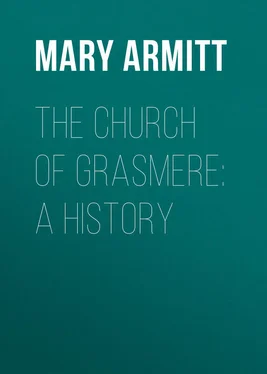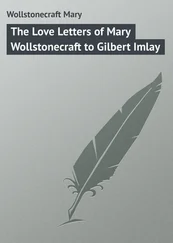Mary Armitt - The Church of Grasmere - A History
Здесь есть возможность читать онлайн «Mary Armitt - The Church of Grasmere - A History» — ознакомительный отрывок электронной книги совершенно бесплатно, а после прочтения отрывка купить полную версию. В некоторых случаях можно слушать аудио, скачать через торрент в формате fb2 и присутствует краткое содержание. ISBN: , Жанр: foreign_antique, foreign_prose, на английском языке. Описание произведения, (предисловие) а так же отзывы посетителей доступны на портале библиотеки ЛибКат.
- Название:The Church of Grasmere: A History
- Автор:
- Жанр:
- Год:неизвестен
- ISBN:http://www.gutenberg.org/ebooks/43002
- Рейтинг книги:4 / 5. Голосов: 1
-
Избранное:Добавить в избранное
- Отзывы:
-
Ваша оценка:
- 80
- 1
- 2
- 3
- 4
- 5
The Church of Grasmere: A History: краткое содержание, описание и аннотация
Предлагаем к чтению аннотацию, описание, краткое содержание или предисловие (зависит от того, что написал сам автор книги «The Church of Grasmere: A History»). Если вы не нашли необходимую информацию о книге — напишите в комментариях, мы постараемся отыскать её.
The Church of Grasmere: A History — читать онлайн ознакомительный отрывок
Ниже представлен текст книги, разбитый по страницам. Система сохранения места последней прочитанной страницы, позволяет с удобством читать онлайн бесплатно книгу «The Church of Grasmere: A History», без необходимости каждый раз заново искать на чём Вы остановились. Поставьте закладку, и сможете в любой момент перейти на страницу, на которой закончили чтение.
Интервал:
Закладка:
Then too a thrilling event in hagiological history touched our parts nearly. When the monks of Lindisfarne fled before the ravaging Danes with St. Cuthbert's body, they went westward for safety, and their wanderings brought them into Cumberland and Westmorland. 14 14 See "Translation of St. Cuthbert." Transactions Cumberland and Westmorland Antiquarian Society, part 1, vol. ii.
A gap in their travels which the antiquary has yet failed to trace may possibly have been filled by a route through Craven – that perpetual haunt of refugees – and about Morecambe Bay.
Certainly a well-used road must have passed not far from our district in the days of Northumbrian anarchy, when Danish kings and allies reigned alike at York and at Dublin. Windermere indeed is associated with the murder (741) of two young princes of the royal house. 15 15 See D. F. Hodgkin's History of Northumberland .
THE DEDICATION
To the question so often asked, When was the church of Grasmere founded? no more than a conjectural answer can be given. The district formed part – though a remote one – of Northumbria, and doubtless shared in the conversion of that kingdom. Even before that time it may have been touched by those successive missionary efforts, which have been happily classed as the Romano-British of Ninian at the end of the fourth century, the Irish of Patrick in the fifth century, and the Kymric of Kentigern in the sixth; and these efforts were followed up by the steady work of the Anglo-Scottish monks, and the establishment under the Anglian kings of an organized church. 16 16 See "Lost Churches in Carlisle Diocese," Transactions Cumberland and Westmorland Antiquarian Society, vol. XV.
The dedication of the Grasmere church favours the supposition that its foundation was early. Its name-saint is King Oswald, who planted a cross as a standard in the battle by which he gained Northumbria, and who was killed at Maserfeld by the heathen Penda in 642. He became the idol of the Northumbrian christians, and his relics were cherished in many a shrine. When danger threatened Lindisfarne, his head was placed for safety in the coffin of St. Cuthbert; 17 17 Where it is still, with the mark of a cut from sword or battle-axe plain to see. – Ed.
and with this sacred burden the monks, as stated above, fled westward, wandering for years in parts adjacent to Westmorland, if they did not actually cross its borders.
A well in the Grasmere valley shared the dedication with the church, and indeed may have been antecedent to it, as a place of resort. It is at the foot of Kelbarrow (formerly Kelbergh, 18 18 Monkbergh by Windermere has become Mountbarrow.
the hill of the spring); and the Celts were wont to decorate their kels or springs with votive offerings of a heathen kind. The church, however, always took care to possess herself of such wells, absorbing any sanctification that was ascribed to them; and the water of St. Oswald's well continued to be carried to the church for baptisms until quite recent times. 19 19 The spot was pointed out to Mrs. Simpson by the Rev. Edward Jefferies, who from 1840 was curate in charge.
Church and well are not, however, close together. The well springs in the flat meadow between the path to the Wray and Wray Beck, but it is now covered in. The adjacent bay of the lake is called Well-foot, and the bridge over the beck has the same name; and when the Wray property was "boundered" in 1683, the "welfoot bridge" was spoken of.
It is suggestive that the farmstead close by owns the name of Pavement End, being formerly known as Padmire. Could it be proved that the name is an ancient one, the idea that the spot was much resorted to of old would be confirmed, since the causeway went so far and no farther. 20 20 I find, however, in deeds of the early seventeenth century, only Padman hereabouts. Or is this a mistake for Padmar? Padman appears in the register.
THE SITE
The present site of the church may not have been the original one. It is hardly a likely halting-place for a travelling preacher. The Roman road which traversed the valley could neither have been the present one, that leads to church and village, nor the straight cut from Town End that passes the Swan Inn. Both of these cross the flat bottom; and the Romans from the summit of White Moss (by which they certainly entered the vale) would never have dropped into the marsh below (even now water-logged in places), only to climb out again, to that gap of the Raise that plainly beckoned them to their goal northward. Instead, they would maintain their level as far as might be, and keep along the firm slope of the fells at a height of some 300 to 400 feet; then, with only two rapid becks to ford, they would come easily and gradually to the ascent of the pass. It is interesting to find that along this presumed route there exists a line of scattered homesteads; while the modern road below was – until the recent spurt in building, vacant but for a cottage and the Swan Inn; and this last stands in reality on an ancient cross "loaning" between the higher road suggested, and the village. Many of these homesteads have been turned into houses for the wealthy, and great alterations have taken place; but a track the whole way may still be made out, though hidden in places by private drives and occupation roads. From White Moss it dropped but little at first, passing behind the highest of the modern houses, according to the belief of old people, who say that this section of it, though remembered, was stopped up before their time. It touched How Head, a farmhold now deserted; then the Hollins, Forest Side, Ben Place and Beck Houses. It crossed Greenhead Gill and passed behind Knott Houses, Winterseeds and Gillside, continuing by the present ford over Tongue Gill, whence the pass is soon gained.
Now of these names many represented of old not one house, but a couple or even a group. Doubtless most of them were planted by the Norse settlers either upon or below the Roman road, on some spot conveniently above their meadows and common field; and devious lanes would in time become trodden between one and another, to the final discarding of the old straight track. Still this can be traced in places; and a bit to be seen above Winterseeds is probably the actual Roman road. A stone celt was recently found in the beck close below it. A quern was also found not far off. 21 21 See Transactions Cumberland and Westmorland Antiquarian Society, N.S. 3, p. 419.
The fact that a smithy existed until recently at Winterseeds – which is only reached now by climbing the steep brow from the main road – is strong presumptive evidence of an old line of traffic passing by it. There the last of the smiths, John Watson, made the ironwork of the present outer church-door. When he became old, a smithy was set up on the lower road, at Tongue Gill.
Now it is a singular fact that a field lying a little below this road, near the gateway of Forrest Side, bears the name of Kirk How. And there is a tradition attached to the spot. It is said that the church of the valley was to have been built here, and that the materials were even gathered together ready for the start; when lo! they vanished in the night-time, only to be found upon the present site, and that a second attempt only produced a like result, the inference being conveyed, by sly looks and chuckles on the part of the narrator, that the task had been wrought by some supernatural Being, not to be lightly mentioned. Whether this was the Hob, or Hobthrush who played so large a part in the stories of the past, cannot be said, but the legend, in its humorous fearlessness, and love of a practical joke, is characteristic of the dalesman, 22 22 The same legend is attached to three Lancashire churches, the foundations of which date back to Saxon times. One is St. Oswald's, Winwick, where the saint's well was once a place of resort. Tradition has preserved, in the case of St. Chad's, Rochdale, some particulars of the elfish rabble who wrought the change. See Memorials of Old Lancashire , vol. – , p. 91-92.
and coupled with the name of the field it is suggestive. It seems possible that here, at a spot where a traveller upon the road might so conveniently halt and set up his cross and portable altar, an early rude (perhaps timbered) structure may actually have once stood. A well, too, for baptism was not far off. There is one in the grounds of the Hollins whose water has remained in repute, and which was examined by an expert at the time (1843) when an effort was made to establish a hydropathic cure in Grasmere. 23 23 From Edward Wilson, parish verger till November, 1906. His father, a joiner like himself, did the woodwork for the hydropathic establishment.
The water was then pronounced finer than that of St. Oswald's Well; but as the owner of the land would not sell, the establishment was placed at the Wray, close to St. Oswald's. The enterprise, started by Mr. Phillips, and conducted by a resident doctor and a German bathman, was not successful, and was given up in five or six years. If the well at the Hollins ever had a name, it is now unknown.
Интервал:
Закладка:
Похожие книги на «The Church of Grasmere: A History»
Представляем Вашему вниманию похожие книги на «The Church of Grasmere: A History» списком для выбора. Мы отобрали схожую по названию и смыслу литературу в надежде предоставить читателям больше вариантов отыскать новые, интересные, ещё непрочитанные произведения.
Обсуждение, отзывы о книге «The Church of Grasmere: A History» и просто собственные мнения читателей. Оставьте ваши комментарии, напишите, что Вы думаете о произведении, его смысле или главных героях. Укажите что конкретно понравилось, а что нет, и почему Вы так считаете.












